Progress towards the emission reduction commitments
The National Emission reduction Commitments Directive (NEC Directive) sets obligations to reduce national emissions of five air pollutants, namely fine particulate matter (PM2.5), nitrogen oxides (NOx), non-methane volatile organic compounds (NMVOCs), ammonia (NH3) and sulphur dioxide (SO2) (EU, 2016). The directive targets 2020-2029, with more ambitious obligations from 2030 onwards.
The analysis presented in this briefing is based on the latest air pollutant emission inventory data[1] reported by Member States in 2024, which refer to emissions up to the year 2022. Member States have reported annual emissions since 1990 and particulate matter since 2000.
Box 1. Policy context
The NEC Directive sets national commitments to reduce emissions of five air pollutants (NOx, NH3, SOx, NMVOC and PM2.5) due to their significant negative impacts on human health and the environment. These national emissions reduction commitments were transposed from the Gothenburg Protocol of the Convention on Long-range Transboundary Air Pollution (UNECE Air Convention).
The NEC directive is one of the legislative instruments within the framework of the European Green Deal supporting the zero pollution ambition to achieve a toxic-free environment. It is particularly critical to deliver on the 2030 targets related to air pollution under the Zero Pollution Action Plan (EC, 2022a). These are to reduce the number of premature deaths caused by air pollution by 55% and to reduce the area of EU ecosystems where air pollution threatens biodiversity by 25%, in both cases compared to 2005 levels. To achieve these targets, it will be vital that EU Member States meet their respective emission reduction commitments set for 2020-2029 and for 2030 onwards under the NEC Directive.
Under the NEC Directive, Member States are obliged to draw up and implement National Air Pollution Control Programmes (NAPCPs), including measures to reduce emissions from relevant sectors to meet national emission reduction commitments and improve air quality. These Programmes should work in connection with other policies such as climate change mitigation. Ensuring consistency across policies strengthens the impact of public interventions; in other words, the implementation of policies and measures.
Status of achieving the 2020-2029 emission reduction commitments under the NEC Directive
The most recent data (reported by Member States in 2022) indicate that 16 Member States met the emission reduction commitments set for 2020-2029 for all five main air pollutants. Reducing ammonia emissions continues to be the most significant challenge for a third of EU Member States.

Notes: This information is based on data provided by Member States, not yet checked by the European Commission. The numbers are subject to change in relation to the results of the NEC Directive inventory review, including through approved flexibility applications.
Source: The air pollutant emission estimates reported in 2022.
Efforts needed to meet national emission reduction commitments for 2020-2029
Most Member States achieved their national emission reduction commitments set for 2020-2029, according to 2022 data. However, 11 Member States failed to meet their emission reduction commitments in 2022 for at least one of the five main air pollutants.
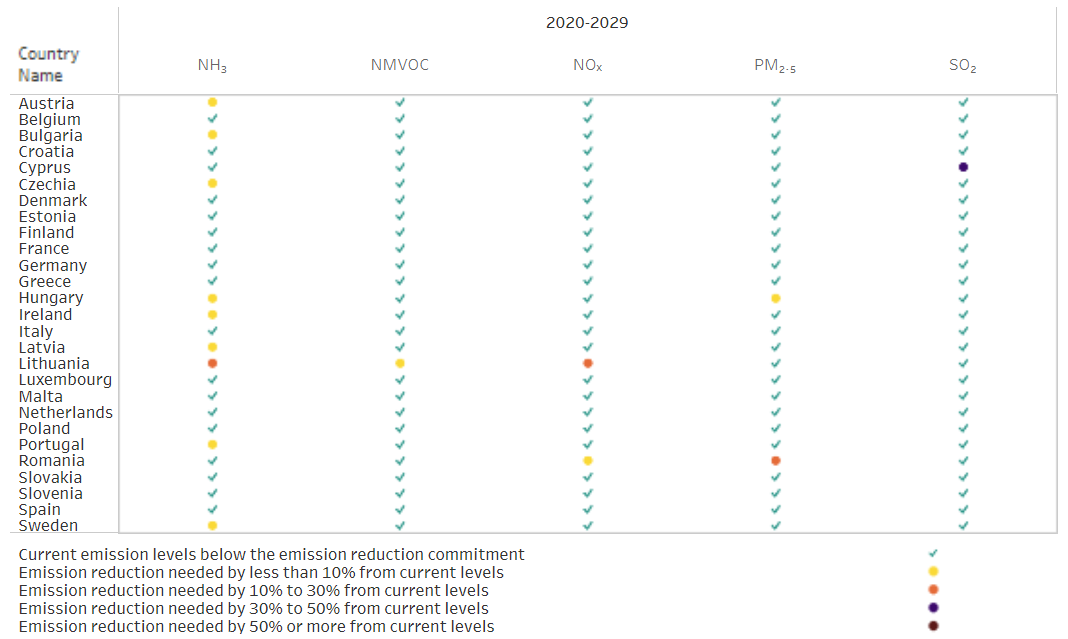
Note(s): 1. The reductions required are compared to 2022 levels.
2. This information is based on data provided by Member States, not yet verified by the European Commission. The numbers are subject to change in relation to the results of the NEC Directive inventory review.
3. The NEC Directive (Article 5(1)) establishes a process that allows Member States to adjust their emission inventories downwards for compliance checking. This can happen when failure to comply with the national emission reduction commitments is due to Member States having applied improved emission inventory methods, which have been updated in accordance with scientific knowledge developed since the reduction commitments were originally set. In 2024, two Member States submitted flexibility applications for an inventory adjustment (Ireland in relation to NMVOC, Czechia in relation to NH3). One Member State (Lithuania in relation to NH3) submitted a flexibility application under Article 5(3) of the NEC Directive which allows, under certain conditions, to compensate non-compliance with an emission reduction commitment by an equivalent emission reduction of another main pollutant. This assessment only takes into account the application by Ireland, given that it is a resubmission of a previously approved application.
Source: The air pollutant emission estimates reported in 2022.
Since 2005, in many EU Member States, NH3 emissions have decreased only slightly or in some cases increased. This highlights the need for more effective policies targeting the agriculture sector to apply well-established agricultural practices that bring down NH3 emissions. This includes practices related to applying fertilisers and manure, and balancing feed for livestock.
Nine Member States will have to reduce NH3 emissions further to meet their 2020-2029 national emission reduction commitments. NH3 emissions impact biodiversity and contribute to forming secondary[2] PM2.5, the main air pollutant driving premature death in EU Member States. Reducing NH3 emissions is critical to achieving the Zero Pollution Action Plan target to reduce by 25% the number of ecosystems in the EU where air pollution threatens biodiversity.
All Member States but one are meeting the 2020-2029 national emission reduction commitments for NMVOC. New technologies and improved production processes in the main NMVOC emission sectors such as manufacturing, extractive industry and product use may reduce air pollutant emissions further.
Lithuania and Romania did not achieve the 2020-2029 national emission reduction commitments for NOx, according to 2022 emission data. A substantial reduction in NOx emissions — especially from road transport — is required to bring the emissions down to the required levels.
Romania and Hungary need to reduce their PM2.5 emissions to meet their 2020-2029 national emission reduction commitments. PM2.5 drives the most significant health problems and contributes to premature mortality, so reducing its emissions is critical to achieving the target of reducing the number of premature deaths by 55% by 2030, as set out in the Zero Pollution Action Plan.
All Member States but one fulfilled their 2020-2029 national emission reduction commitments for SO2. Cyprus still needs to reduce its SO2 emissions by a further 43% to meet its commitment. The principal emission sources for this pollutant in the country are energy supply and manufacturing.
Progress towards the 2030 emission reduction commitments — the path to achieving a zero pollution Europe
New, stricter commitments will enter into force in 2030. Looking towards that milestone, all Member States except for Belgium and Finland need to reduce emissions for at least one pollutant to fulfil their 2030 commitments. The greatest challenge will be to reduce NH3, NOx and PM2.5 emissions.
Even if a given country already meets the 2030 target for specific pollutants, current emission levels and trends suggest further measures need to be in place to avoid increases that would jeopardise these achievements.

Notes: This information is based on data provided by Member States, not yet checked by the European Commission. The numbers are subject to change in relation to the results of the NEC Directive inventory review, including through approved flexibility applications.
Source: The air pollutant emission estimates reported in 2022.
Efforts needed to meet national emission reduction commitments from 2030 and beyond
Member States need to do more to achieve the national emission reduction commitments set from 2030 and beyond. Only two Member States are already meeting their 2030 emission reduction commitments based on the 2022 data for all of the five main air pollutants. In several instances, the distance to the target is very significant and requires far stronger action.
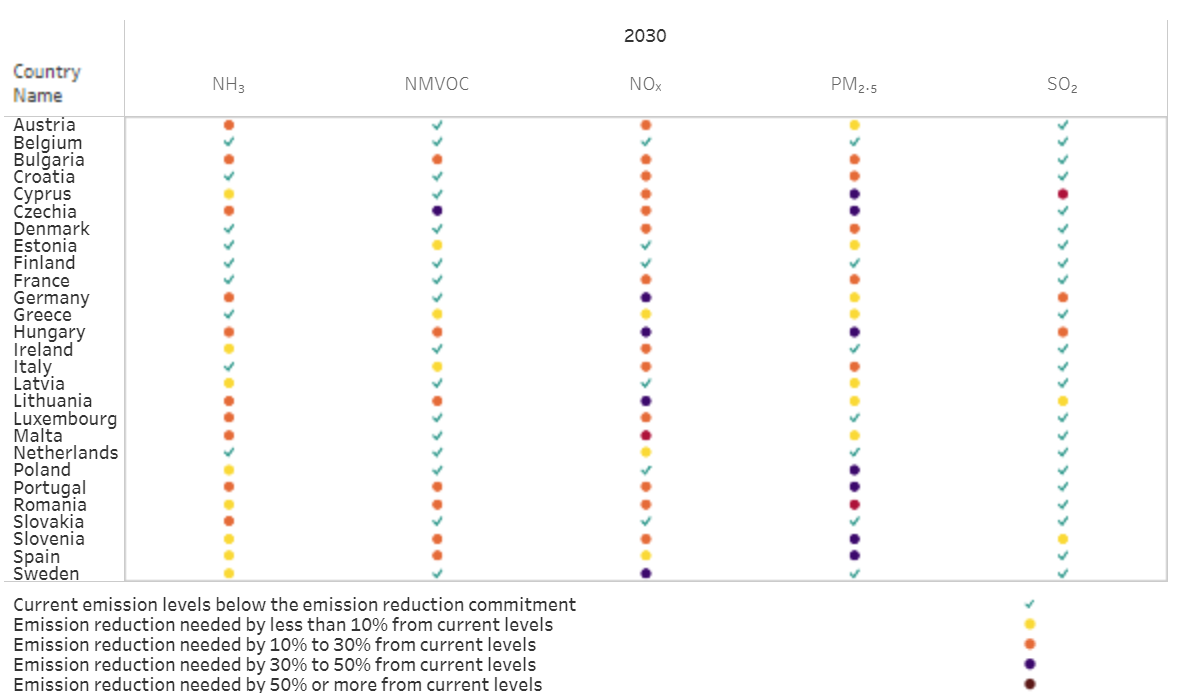
Notes: 1. The emission reductions required are compared to 2022 levels.
2. This information is based on data provided by Member States, not yet verified by the European Commission. The estimates are subject to change in relation to the results of the NEC Directive inventory review.
3. The NEC Directive (Article 5(1)) establishes a process that allows Member States to adjust their emission inventories downwards for compliance checking. This can happen when failure to comply with the national emission reduction commitments is due to Member States having applied improved emission inventory methods, which have been updated in accordance with the latest scientific knowledge developed since the reduction commitments were originally set. In 2024, two Member States submitted flexibility applications for an inventory adjustment (Ireland in relation to NMVOC, Czechia in relation to NH3). One Member State (Lithuania in relation to NH3) submitted a flexibility application under Article 5(3) of the NEC Directive which allows, under certain conditions, to compensate non-compliance with an emission reduction commitment by an equivalent emission reduction of another main pollutant. This assessment only takes into account the application by Ireland, given that it is a resubmission of a previously approved application.
Source(s): The air pollutant emission estimates reported in 2022.
Regarding NH3 emissions, nine Member States had already met their 2030 emission reduction commitments in 2022. Challenges remain, however, as two-thirds of Member States still need to reduce NH3 emissions to meet their 2030 targets. The European Commission’s Third Clean Air Outlook report concluded that current measures — especially in the agriculture sector — are not enough to reduce NH3 emissions to the necessary extent in order to meet emission reduction commitments. It recommended further measures be put in place in several Member States (EC, 2022b).
Seven Member States had already met their 2030 emission reduction commitments for PM2.5 emissions by 2022. Effective emission reduction measures in the energy sector will be crucial for meeting the emission reduction commitments for PM2.5: burning solid biomass and fossil fuels for residential heating still contributes significantly to emissions in some Member States. Actions to reduce emissions include improving insulation and upgrading heating systems, installing low-emission boilers or switching fuel types. Significant emissions of particulate matter also result from the manufacturing and extractive industries and from road transport, including from internal combustion engines and from tyre and brake wear in vehicles.
Six Member States met their NOx emission reduction commitments for 2030 in 2022. However, 21 Member States will need to reduce NOx emissions further. Efforts to reduce NOx emissions should focus on the road transport sector. This is the main source of reported NOx emissions, followed by the energy supply sector.
For emissions of NMVOCs, 16 Member States met their 2030 emission reduction commitments in 2022. As the manufacturing and extractive industry sector is the main emission source, reduction measures for this pollutant should focus on industrial sectors.
The picture for SO2 emissions is more positive overall. Five Member States face challenges to meet the emission reduction commitments in 2030. Energy supply is the principal source of SO2 emissions in the EU, with the manufacturing and extractive industry sector being the second-largest contributor.
Main sources of air pollutants in 2022
The economic sectors responsible for emissions to air vary by pollutant. Variations between Member States also exist due to different economic structures. This section of the briefing displays a visual representation of air pollutant sources. It addresses a broader range of air pollutants than those covered by emission reduction commitments in the NEC Directive (Figure 4).

Source: The air pollutant emission estimates reported in 2022.
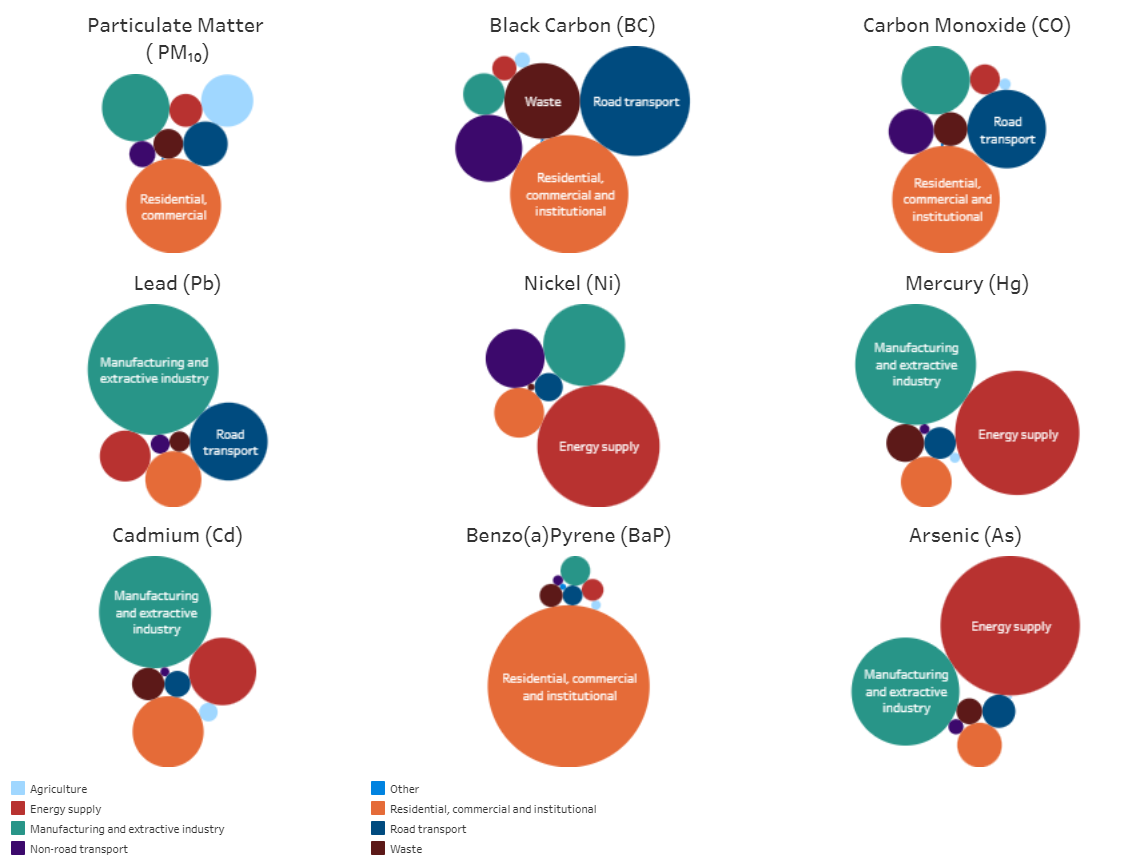
Source: The air pollutant emission estimates reported in 2022.
Past trends in air pollutant emissions, 2005-2022
Total air pollutant emissions across EU Member States declined slightly in 2022, maintaining the overall downward trend observed since 2005. Figure 5 shows the trend in total emissions, indexed as a percentage of their value in the reference year 2005 and set against gross domestic product (GDP) as a percentage of the 2005 value.
From 2005 to 2022, PM2.5 and PM10 emissions fell by 32% and 31%, respectively. Emissions of SO2 fell significantly between 2005 to 2022 with a decrease of 82%. Major reductions were also seen for nitrogen oxides (50%), black carbon (44%), carbon monoxide (42%) and NMVOCs (33%).
Notably, NH3 emissions fell by only 16% — the least out of any pollutant.
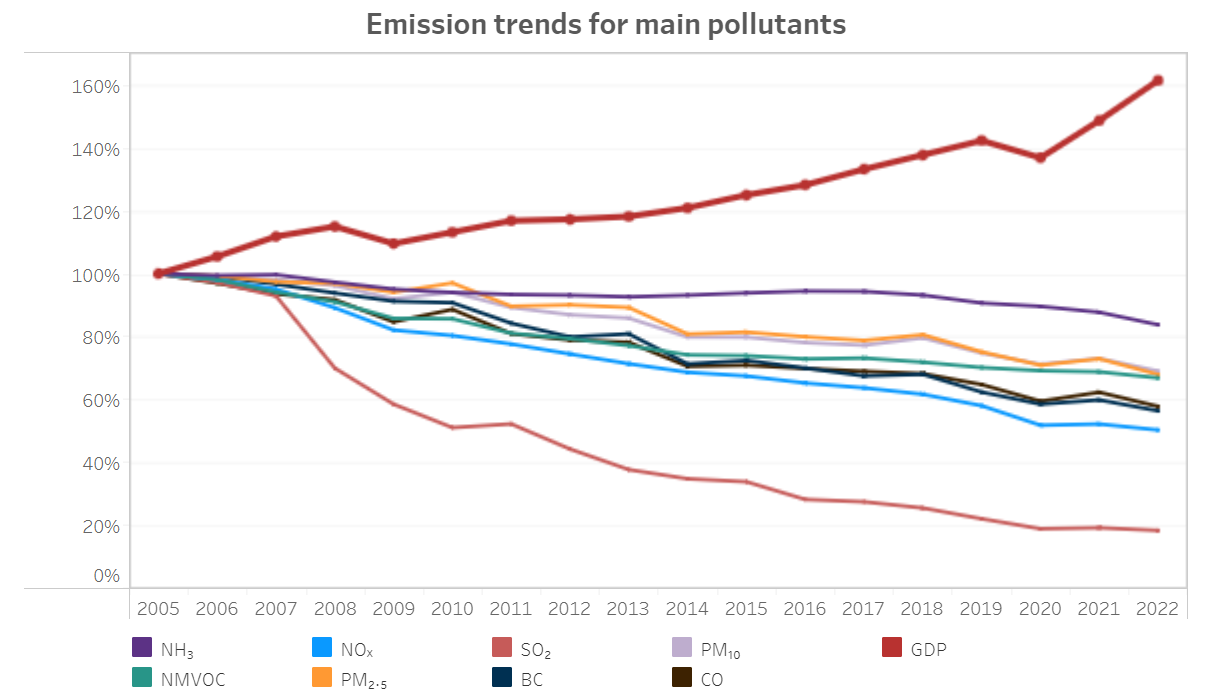
Notes: GDP is the gross domestic product at market prices in euros.
Source: The air pollutant emission estimates reported in 2022.
Figure 6 shows trends in the total emissions of heavy metals and benzo(a)pyrene (BaP) in EU Member States. These are indexed as a percentage of their value in the reference year 2005 and set against EU Member States’ GDP as a percentage of the 2005 value. Emissions of nickel (Ni) and arsenic (As) fell by 69% and 65%, respectively, while mercury (Hg), lead (Pb) and cadmium (Cd) emissions fell by 52%, 44% and 39%, respectively. Emissions of BaP fell by just 22%.
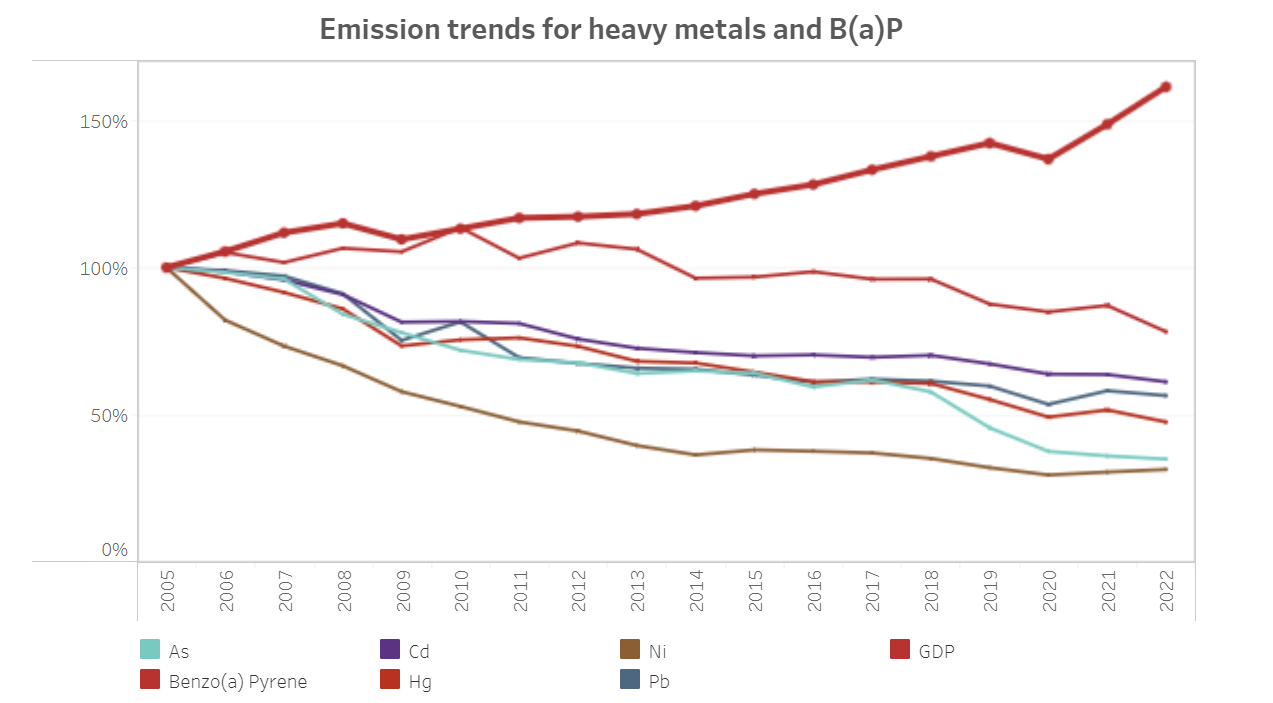
Notes: GDP is the gross domestic product at market prices in euros.
Source: The air pollutant emission estimates reported in 2022.
Emissions showed a significant absolute decoupling from economic activity between 2005 and 2022. Absolute decoupling occurs when an environmental impact variable, such as air pollutant emissions, remains stable or decreases while GDP increases. This leads to lower emissions of main air pollutants for each unit of GDP produced annually. Figures 5 and 6 both show that air pollutant emissions across EU Member States declined between 2005 and 2022, even as GDP increased by 61%. The greatest decoupling is seen for SO2, followed by NOx, BC, CO and certain metals (Ni, As and Hg).
The decoupling of emissions from economic activity may be the result of a combination of factors, such as increased regulation and policy implementation, fuel switching, technological improvements, and improvements in energy or process efficiencies.
Notes
[1] The data presented in this briefing represent 2022 emissions as reported by Member States in 2024 and do not include corrections made during the European Commission 2024 inventory review. These corrections are highly unlikely to have a significant impact on the aggregated EU emission levels, though in some cases they may alter national emissions levels and subsequently performance against an emission reduction commitment.
[2] Primary PM refers to solid or liquid particles directly emitted into the air.
References
EC, 2021, Communication from the Commission to the European Parliament, the Council, the European Economic And Social Committee and the Committee Of The Regions Pathway to a Healthy Planet for All EU Action Plan: 'Towards Zero Pollution for Air, Water and Soil' (COM(2021) 400 final).
EC, 2022a, ‘Zero Pollution Action Plan’, European Commission (https://environment.ec.europa.eu/strategy/zero-pollution-action-plan_en) accessed on 20 April 2024.
EC, 2022b, Third clean air outlook, European Commission (https://environment.ec.europa.eu/publications/third-clean-air-outlook_en) accessed on 20 April 2024.
EEA, 2021, Europe’s air quality status 2021, EEA Briefing no. 06/2021, European Environment Agency (https://www.eea.europa.eu/publications/national-emission-reduction-commitments-directive-2021) accessed on 20 April 2024.
EEA, 2022, Europe’s air quality status 2022, EEA Briefing no. 11/2022, European Environment Agency (https://www.eea.europa.eu/publications/national-emission-reduction-commitments-directive-2022) accessed on 20 April 2024.
EEA, 2023, Europe’s air quality status 2023, EEA Briefing no. 05/2023, European Environment Agency (https://www.eea.europa.eu/publications/europes-air-quality-status-2023) accessed on 20 April 2024.
EU, 2016, Directive (EU) 2016/2284 of the European Parliament and of the Council of 14 December 2016 on the reduction of national emissions of certain atmospheric pollutants (OJ L 344, 17.12.2016, pp. 1-31).
EU, 2021, Regulation (EU) 2021/1119 establishing the framework for achieving climate neutrality and amending Regulations (EC) No 401/2009 and (EU) 2018/1999 (‘European Climate Law’) (OJ L 243, 9.7.2021, pp. 1-17).
Identifiers
Briefing no. 07/2024
Title: Air pollution in Europe: 2024 reporting status under the National Emission reduction Commitments Directive
EN HTML: TH-AM-24-010-EN-Q - ISBN: 978-92-9480-651-2 - ISSN: 2467-3196 - doi: 10.2800/019282
EN PDF: TH-AM-24-010-EN-N - ISBN: 978-92-9480-652-9 - ISSN: 2467-3196 - doi: 10.2800/977119








Document Actions
Share with others